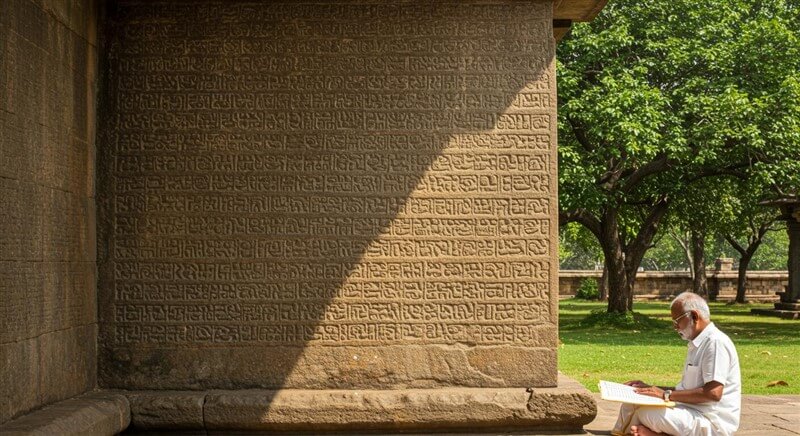Language is more than just a tool for communication; it is a living archive of history, culture, and human evolution. Among the thousands of languages spoken today, a select few have withstood the test of time, surviving for millennia while carrying the essence of ancient civilizations. From the poetic verses of Tamil to the sacred chants of Sanskrit, the resilient revival of Hebrew, the philosophical depth of Greek, and the spiritual legacy of the Coptic language, these tongues are windows into the past. They are not merely words but echoes of humanity’s earliest stories—alive, evolving, and still shaping the world we know today.
Tamil: The Timeless Classical Language

Origins
Tamil is one of the world’s oldest living languages, with origins tracing back over 2,000 years. It belongs to the Dravidian language family and is deeply connected to the ancient Tamil civilization, which thrived in South India. Early Tamil literature, such as the Sangam poetry (circa 300 BCE to 300 CE), showcases the language’s antiquity and literary richness.
Current Status
Today, Tamil remains a vibrant and widely spoken language, with over 70 million native speakers in India, Sri Lanka, Singapore, and Malaysia. It is the official language of the Indian state of Tamil Nadu and is also one of Sri Lanka’s national languages. Unlike many ancient languages, Tamil continues to evolve and flourish as a spoken and written language in daily life, education, media, and government.
Cultural Significance
Tamil is more than just a language; it is a cornerstone of Tamil identity and culture. Its literature, spanning millennia, includes epic poetry, spiritual texts, and philosophical works. Tamil is also recognized as one of India’s six classical languages, celebrated for its unbroken tradition and cultural depth. The language embodies a rich heritage, preserving the voices and wisdom of an ancient civilization while remaining relevant in the modern world.
Sanskrit: The Language of the Gods

Origins
Sanskrit, often referred to as “the language of the gods”, is one of the oldest and most influential languages in human history. Its origins date back over 3,000 years, flourishing during the Vedic period (circa 1500 BCE). As part of the Indo-European language family, Sanskrit formed the foundation of Hinduism, Buddhism, and Jainism’s sacred texts, including the Vedas and Upanishads. The language’s precise structure and grammar were codified by the ancient scholar Panini in his monumental work, Ashtadhyayi.
Current Status
Although Sanskrit is no longer used as a native spoken language, it remains a liturgical and scholarly language. It is still actively used in Hindu religious rituals, Buddhist chants, and academic research across the world. In India, Sanskrit is one of the 22 officially recognized languages, and efforts are being made to revive it through schools, universities, and cultural organizations.
Cultural Significance
Sanskrit is the bedrock of many modern Indian languages and has profoundly influenced global thought systems. Its vast corpus of literature encompasses philosophy, science, mathematics, medicine, and the arts. Beyond its intellectual legacy, Sanskrit’s phonetic beauty and precise grammar have earned it a reputation as one of the most sophisticated languages ever created, preserving humanity’s spiritual and intellectual heritage for millennia.
Hebrew: The Language of Revival

Origins
Hebrew is an ancient Semitic language with roots tracing back over 3,000 years. It was the primary language of the Israelites and the ancient Jewish kingdoms. The earliest known examples of written Hebrew date to around the 10th century BCE, found in inscriptions and religious texts, including the Hebrew Bible (Tanakh). For centuries, it served as the language of Jewish religion, culture, and scholarship.
Current Status
Hebrew underwent a remarkable transformation from a nearly extinct spoken language to a thriving modern language. By the 2nd century CE, it had largely ceased to be a spoken language, surviving primarily as a liturgical and scholarly medium. However, in the late 19th and early 20th centuries, Eliezer Ben-Yehuda and others spearheaded its revival as a spoken language. Today, modern Hebrew (Ivrit) is the official language of Israel and is spoken by over 9 million people worldwide, blending its ancient roots with contemporary usage.
Cultural Significance
Hebrew is unique in its story of revival, symbolizing the endurance and resilience of Jewish culture and identity. It connects the Jewish people to their ancient texts and traditions while also serving as a vibrant, evolving language of everyday life, literature, and innovation. Its rebirth is often regarded as one of the greatest linguistic achievements in history.
Greek: The Language of Philosophy and Civilization

Origins
Greek is one of the world’s oldest recorded languages, with a written history spanning over 3,400 years. It belongs to the Indo-European language family and is closely tied to the rise of Ancient Greece, one of the most influential civilizations in history. Early Greek literature, such as Homer’s Iliad and Odyssey, dates back to around the 8th century BCE, while Linear B inscriptions from Mycenaean Greece date even earlier, to around 1450 BCE.
Current Status
Greek has evolved significantly from its ancient forms but remains a living language with over 13 million speakers today, primarily in Greece and Cyprus. Modern Greek is the official language of both nations, and it continues to be used in literature, science, and daily communication. While Ancient Greek is no longer spoken conversationally, it is studied worldwide for its profound impact on philosophy, science, and Western culture.
Cultural Significance
Greek is the language of some of the greatest thinkers in history, including Plato, Aristotle, and Socrates. It served as the foundation for Western philosophy, democracy, and science. The Greek alphabet, one of the first phonetic writing systems, also influenced many modern alphabets. Its legacy is immortalized not only in its ancient texts but also in its continued use in academic and cultural contexts, bridging the ancient and modern worlds.
Coptic: The Last Echo of Ancient Egypt

Origins
The Coptic language is the final stage of the Ancient Egyptian language, with roots dating back over 5,000 years to the time of the Pharaohs. Written in a modified Greek alphabet with additional characters from Demotic Egyptian, Coptic emerged around the 2nd century CE. It became the language of the early Christian Church in Egypt and played a critical role in the spread of Christianity across the region.
Current Status
Though it ceased to be a spoken vernacular language by the 17th century, Coptic remains a liturgical language used in the religious services of the Coptic Orthodox Church. It is studied by scholars and preserved by religious communities as a vital part of Egypt’s cultural and spiritual heritage. Efforts are ongoing to teach and revive the language within the Coptic Christian population.
Cultural Significance
Coptic is more than just a language; it is a bridge between Ancient Egypt and modern Egyptian identity. It preserves the linguistic essence of one of the world’s oldest civilizations and reflects Egypt’s transition from Pharaonic traditions to Christianity. Its influence can still be seen in Egyptian Arabic and in the cultural practices of the Coptic Church, making it a living relic of Egypt’s rich history.
Conclusion: Echoes of the Past
The world’s oldest languages, like Tamil, Sanskrit, Hebrew, Greek, and Coptic, are more than relics of history—they are bridges connecting us to ancient civilizations. Each carries a unique legacy of culture, spirituality, and knowledge, reminding us of the resilience of human expression. Preserving these languages honors the past while inspiring future generations to cherish the richness of linguistic and cultural diversity.


 ByKus
ByKus Historia
Historia Logos
Logos Humanitas
Humanitas Aesthetica
Aesthetica Cinemania
Cinemania Lingua
Lingua Mythos
Mythos Theologia
Theologia Bibliotecha
Bibliotecha Persona
Persona Quid
Quid News
News Politico
Politico Mundialis
Mundialis Oeconomia
Oeconomia Athletica
Athletica Technologia
Technologia Medicina
Medicina Scientia
Scientia Astronomia
Astronomia













